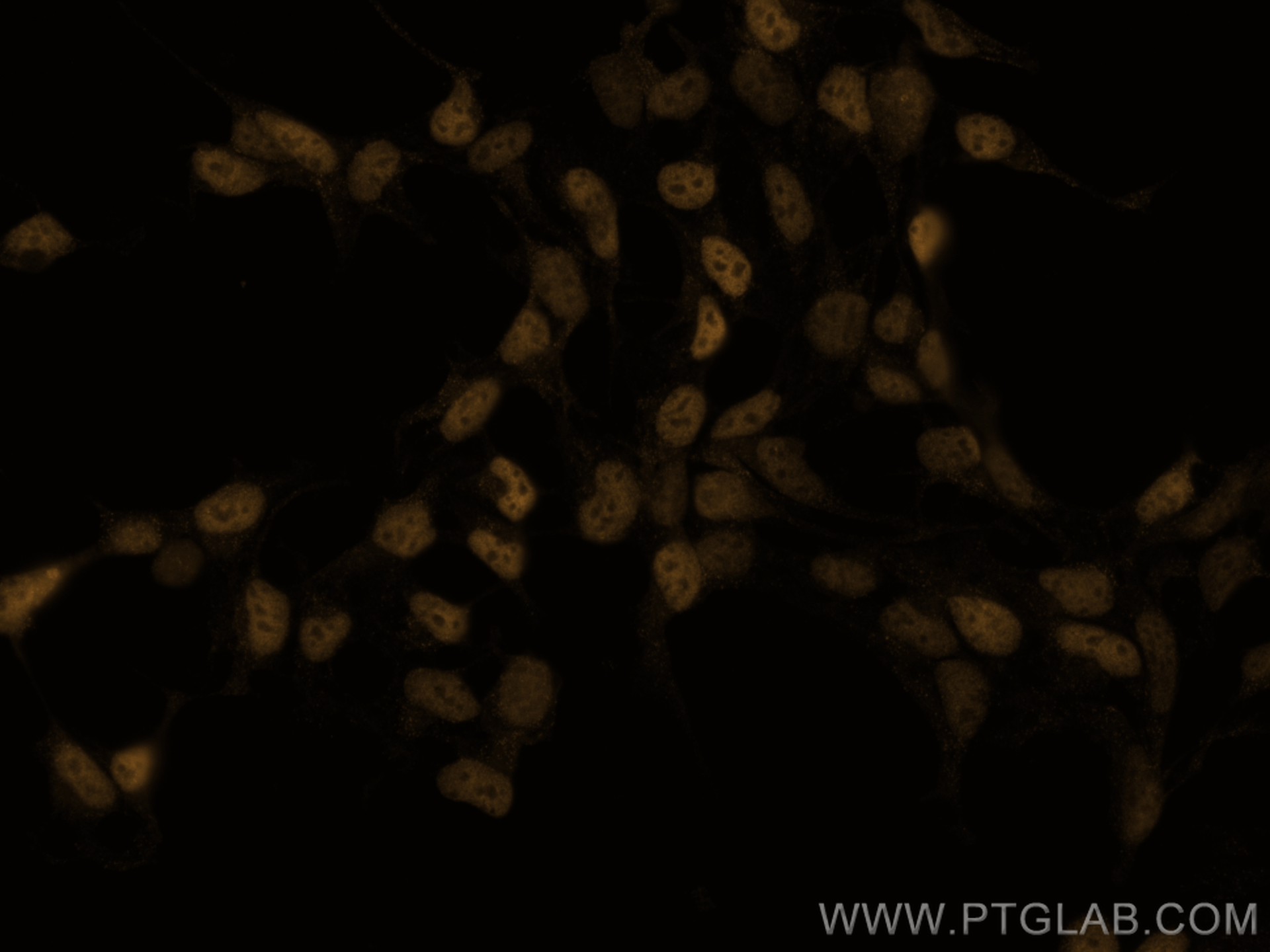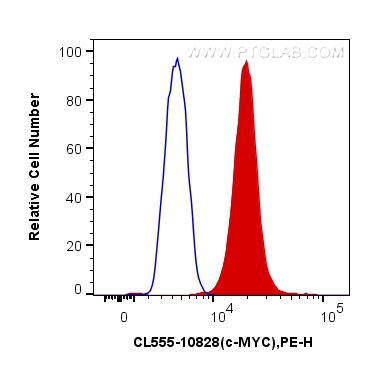验证数据展示
经过测试的应用
| Positive IF/ICC detected in | HEK-293 cells |
| Positive FC (Intra) detected in | Raji cells |
推荐稀释比
| 应用 | 推荐稀释比 |
|---|---|
| Immunofluorescence (IF)/ICC | IF/ICC : 1:50-1:500 |
| Flow Cytometry (FC) (INTRA) | FC (INTRA) : 0.20 ug per 10^6 cells in a 100 µl suspension |
| It is recommended that this reagent should be titrated in each testing system to obtain optimal results. | |
| Sample-dependent, Check data in validation data gallery. | |
产品信息
CL555-10828 targets c-MYC in IF/ICC, FC (Intra) applications and shows reactivity with human, mouse samples.
| 经测试应用 | IF/ICC, FC (Intra) Application Description |
| 经测试反应性 | human, mouse |
| 免疫原 |
CatNo: Ag1263 Product name: Recombinant human MYC protein Source: e coli.-derived, PGEX-4T Tag: GST Domain: 16-454 aa of BC000141 Sequence: MPLNVSFTNRNYDLDYDSVQPYFYCDEEENFYQQQQQSELQPPAPSEDIWKKFELLPTPPLSPSRRSGLCSPSYVAVTPFSLRGDNDGGGGSFSTADQLEMVTELLGGDMVNQSFICDPDDETFIKNIIIQDCMWSGFSAAAKLVSEKLASYQAARKDSGSPNPARGHSVCSTSSLYLQDLSAAASECIDPSVVFPYPLNDSSSPKSCASQDSSAFSPSSDSLLSSTESSPQGSPEPLVLHEETPPTTSSDSEEEQEDEEEIDVVSVEKRQAPGKRSESGSPSAGGHSKPPHSPLVLKRCHVSTHQHNYAAPPSTRKDYPAAKRVKLDSVRVLRQISNNRKCTSPRSSDTEENVKRRTHNVLERQRRNELKRSFFALRDQIPELENNEKAPKVVILKKATAYILSVQAEEQKLISEEDLLRKRREQLKHKLEQLRNSCA 种属同源性预测 |
| 宿主/亚型 | Rabbit / IgG |
| 抗体类别 | Polyclonal |
| 产品类型 | Antibody |
| 全称 | v-myc myelocytomatosis viral oncogene homolog (avian) |
| 别名 | MYC, Myc proto oncogene protein, MRTL, Class E basic helix-loop-helix protein 39, c Myc |
| 计算分子量 | 49 kDa |
| 观测分子量 | 62-65 kDa, 50 kDa |
| GenBank蛋白编号 | BC000141 |
| 基因名称 | MYC |
| Gene ID (NCBI) | 4609 |
| RRID | AB_2919593 |
| 偶联类型 | CoraLite®555 Fluorescent Dye |
| 最大激发/发射波长 | 557 nm / 570 nm |
| 形式 | Liquid |
| 纯化方式 | Antigen affinity purification |
| UNIPROT ID | P01106 |
| 储存缓冲液 | PBS with 50% glycerol, 0.05% Proclin300, 0.5% BSA, pH 7.3. |
| 储存条件 | Store at -20°C. Avoid exposure to light. Stable for one year after shipment. Aliquoting is unnecessary for -20oC storage. |
背景介绍
Function
c-Myc (also known as Myc), together with l-Myc and n-Myc, belongs to the Myc family of transcription factors. c-Myc has a basic helix-loop-helix leucine zipper domain and through heterodimerization can bind and regulate the transcriptional activity of genes, either by repression or activation. It is a key player in the regulation of cell growth and cell cycle progression and acts as a proto-oncogene.
Tissue specificity
c-Myc is ubiquitously expressed in almost all cell types and its expression positively correlates with tissue proliferative capacity. c-Myc is also expressed during embryogenesis and is upregulated in many cancer types.
Involvement in disease
· Upregulated in many cancer types, especially in aggressive, poorly differentiated tumors.
· Mutations in the MYC gene and breakpoint translocations within the MYC gene cause Burkitt lymphoma.
Isoforms
There are 3 different isoforms of c-Myc: c-Myc1, c-Myc2, and c-MycS (PMID: 16260605). They differ in molecular size, can be preferentially expressed during cell growth, and are reported to be functionally distinct.
Post-translational modifications
c-Myc is subject to various post-translational modifications, including phosphorylation, acetylation, and ubiquitinylation (PMID: 16987807), which regulate its activity.
Cellular localization
c-Myc localizes to the nucleus but can also be present in the cytoplasm of certain cancer types.
实验方案
| Product Specific Protocols | |
|---|---|
| IF protocol for CL555 c-MYC antibody CL555-10828 | Download protocol |
| Standard Protocols | |
|---|---|
| Click here to view our Standard Protocols |



